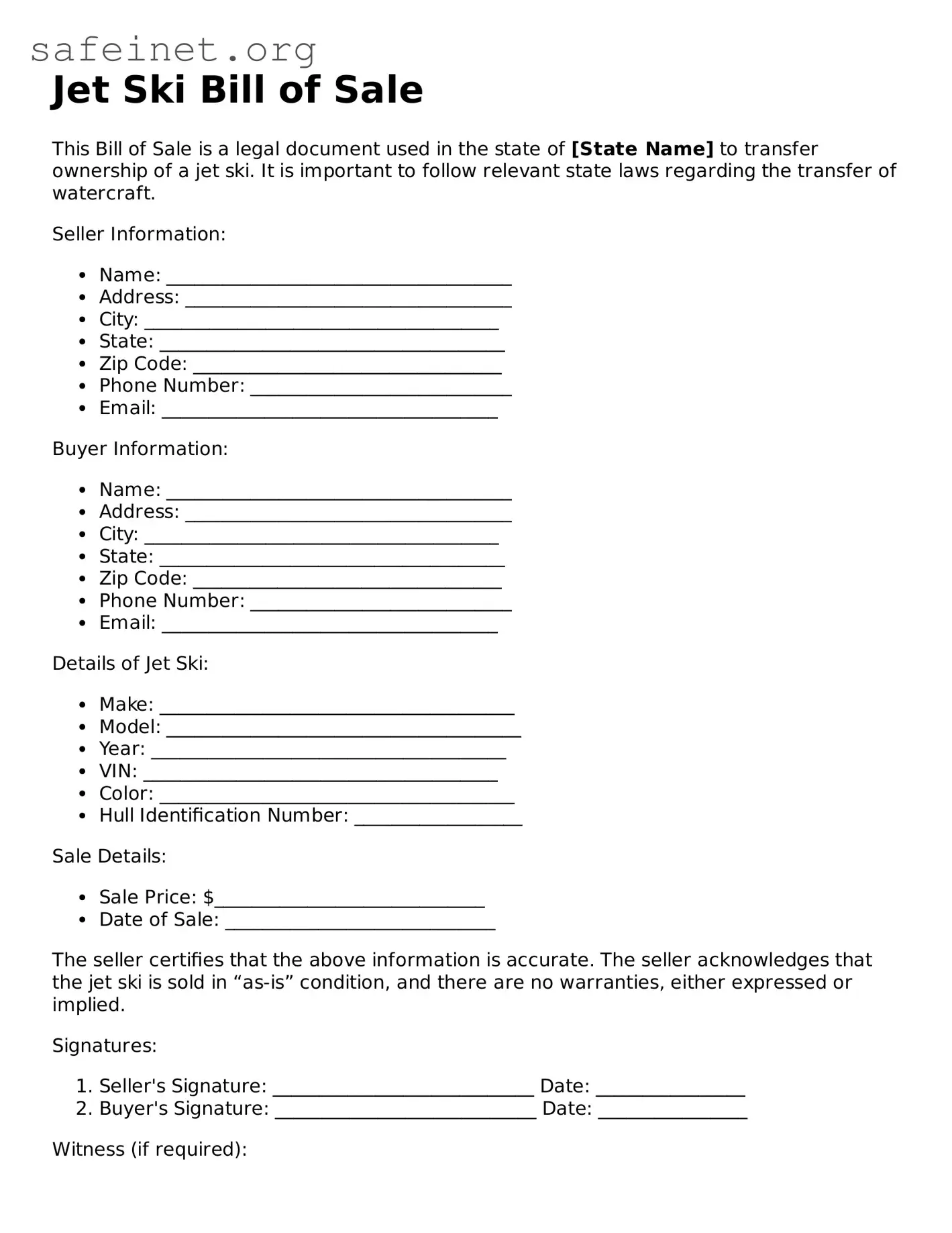The Jet Ski Bill of Sale form shares similarities with a Vehicle Bill of Sale. Both documents serve as proof of a transaction between two parties, detailing the sale of a personal item, whether it be for a motor vehicle or a watercraft. Each form typically includes essential information such as the buyer and seller’s names, contact details, and the purchase price. This ensures clarity and minimizes disputes after the sale, as both parties have a written record of the terms involved in the transaction.
Another comparable document is the Boat Bill of Sale. Like the Jet Ski Bill of Sale, this form records the transfer of ownership of a boat from one individual to another. It also includes pertinent details such as the vessel’s identification number, the condition of the boat, and any warranties or guarantees offered by the seller. Both forms aim to provide legal proof of ownership and protect the rights of both the buyer and seller.
Similar to both is the Motorcycle Bill of Sale. This document functions much like the Jet Ski version, as it outlines the sale process of a motorcycle. Key identifiers, including the motorcycle's make, model, and Vehicle Identification Number (VIN), are essential components found in both forms. They provide assurance to buyers about the legitimacy of their purchase and security for sellers that the transfer is documented and recognized.
The ATV Bill of Sale is another document that mirrors the Jet Ski Bill of Sale in purpose and content. When buying or selling an all-terrain vehicle, this form records the transaction details, ensuring all involved parties acknowledge the specifics of the sale. It includes similar elements such as the buyer’s and seller’s information, description of the ATV, and any conditions pertaining to the sale, thus protecting interests on both sides.
When discussing similar documents, the Snowmobile Bill of Sale comes to mind. This form operates on the same principles as Jet Ski transactions, where the document outlines the sale between the buyer and seller. Both documents capture critical details about the vehicle, including serial numbers and any additional warranties. They ensure that the exchange is officially documented and help avoid potential disputes in the future.
The Personal Watercraft Bill of Sale is an essential counterpart to the Jet Ski Bill of Sale. Personal watercraft refers to various types of jet skis and similar vehicles, and the bill of sale serves to outline the terms under which the ownership is transferred. Essential details about the craft, including condition and price, along with signatures from both parties, are typically included, mirroring the format and purpose of the Jet Ski Bill of Sale.
The Trailer Bill of Sale also shares significant similarities with the Jet Ski Bill of Sale. This document is used to record the sale of a trailer that may serve various purposes, including transporting the Jet Ski itself. It contains standard information, such as the buyer's and seller's identities, vehicle description, and purchase agreement. Both documents aim to document legally binding agreements and safeguard the interests of both parties.
The Furniture Bill of Sale is another related document, albeit for a different type of transaction. It serves a similar purpose by providing evidence of the sale of furniture between parties. The form outlines vital details such as descriptions of the items sold, total price, and any conditions attached to the sale. Like the Jet Ski Bill of Sale, it offers protection and a clear record of ownership transfer.
Finally, the General Bill of Sale can be viewed as an overarching document to which the Jet Ski Bill of Sale belongs. This versatile form can be used for the sale of virtually any personal property, from electronics to vehicles. It provides a straightforward way to record sales and includes necessary information, similar to that found in the Jet Ski Bill of Sale, ensuring that all transactions are legally documented and recognized by both parties.
